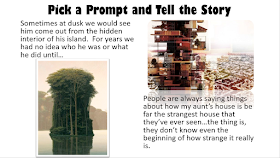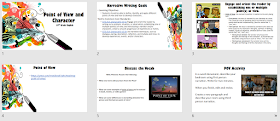The first day, students take notes on basic narrative terms. For each term, they are reminded of what they learned in their 9th grade year and then asked to build on that understanding.
On the next day, students are asked to engage in a series of brief writes as a brainstorming activity. The idea is that one of these brief writes might be developed into a final creative narrative or elements of the brief writes might serve as inspiration for a final narrative. Essentially students select between 2 prompts and complete timed free-writes on them. The only rule: the students have to write for the entire time. Here are some sample prompts:
After this, students are asked to outline the basic plot, theme, characters, setting, etc. for their narrative. If they are stumped, they are able to draw from the Writer's Block Sticks in order to help them to develop their ideas.
The next day, students are asked to mindfully integrate theme throughout the plot of their narrative. They outline this on a thematic mapping outline.
They are then given supports in order to help them to develop the setting. They review brief notes and work on considering setting as a way to develop both characters and mood. Finally, they work to develop settings appropriate to the narratives they are writing.
They are then guided through the development of point-of-view and characters. They are given notes on characters and then asked to complete in-depth character questionnaires for the characters in their narratives in order to make them well-rounded and get to know them better.
This video provides an excellent description of the art of creative writing and the importance of vivid language in narrative writing:
Finally, students write their narratives. Just like on the SBA, they write into the narratives of others. They will follow all provided outlines and other formative work. They write the exposition and initiating event and edit the next day. Then, they add onto the narrative of a peer. They write the Rising Action and Climax. The next day is spent editing. Finally, they write the Falling Action and Resolution for a third narrative. A day is spent editing. On each day of editing, writers receive feedback through two means: direct, HELPFUL comments on their narratives and a Reader Review Worksheet. Writers are then asked to take all comments into consideration and make revisions based off the feedback received.
A final day is spent making any revisions and making certain that the narratives pass the yes-test and will do well on the rubric.






















No comments:
Post a Comment